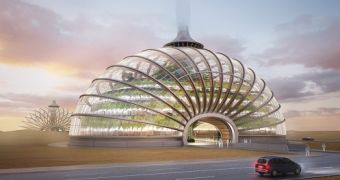Nowadays, modern architecture has to respond to several challenges. Apart from building structures that look amazing, experts must take into consideration extra measures of precaution to safeguard their masterpieces from climate change effects, like floods generated by raising sea levels.
A team of Russian architects from Remistudio seems to have achieved just that: designing a jaw-dropping building, looking like a giant shell, receiving a great green boost from renewable sources of power.
The enormous Ark is also considered to be one of the most reliable structures, coping with natural disasters in an ideal manner.
According to its developers, the concept of a bioclimatic house comes along with 'independent life support sources.' One of the main assets making the Ark truly remarkable is its framework, covered entirely by a Ethyl TetraFluoroEthylene (ETFE)-based foil, which provides several advantages.
It is easy to clean, lighter than glass, transparent, self-cleaning, recyclable. All these awesome features make it, by far, the best candidate for the job and the most economic option taking into consideration its prolonged lifespan.
Metal profiles, especially designed to install the foil on the framework, can also act as solar collectors heating water supplies and could also play an important part in collecting rainwater on the roof.
The shape of the structure is also favoring the installation of photoelectric cells in a suitable position to harness a maximum amount of sunlight.
Apart from being basically energy independent, since it can exploit alternative power coming from water, air or ground, the structure is also supposed to float on the ocean, in case rising sea levels get out of control in the near future.
"The form of the cupola assists to agglomeration of the warmed air in the upper part. This heat is collected in seasonal heat accumulators, in electric and hydrogen accumulators, in order to provide an uninterrupted energy supply for the whole complex in spite of the outer environment conditions," explain the architects.
Plants also play an important role in the Ark, since they are selected accordingly to their oxygen output and illumination requirements, in order to highlight the strong connection between people, plants and living spaces.

 14 DAY TRIAL //
14 DAY TRIAL //